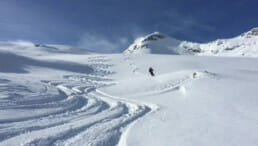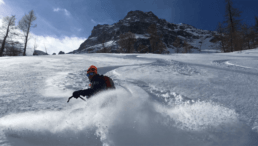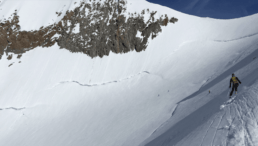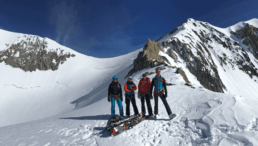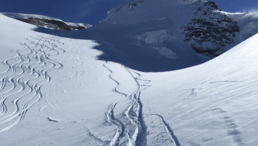Preparation
In negotiation it is said that 80% of the results is obtained before sitting down at the negotiating table and only 20% depends on the actual activity of interacting with the counterpart. The same logic can also be applied to everyday activities and, of course, to sports.
To enjoy a day of helicopter skiing to the fullest, you have to be mentally and physically ready.
The first time you go, keeping your head will be the most difficult part, because it perceives and unites the triple uncertainty about the safety of the helicopter, the difficulty of the descent, and the risk of avalanche.
If you suffer from dizziness, claustrophobia, or any disorder that objectively prevents you from boarding a helicopter, you can forget about heliskiing. On the contrary, if it is only a feeling, try to make one last attempt before moving on: speak to people who have had this experience and have them tell you how it went. Their words will surely have a positive effect and may give you the motivation you need to try for yourself.
As regards the difficulty, a point I will return to again and again, it is a little like when you decide whether to tackle the red or the black piste in a ski resort, here you will have the same choice.
Depending on your ability, you can identify more challenging or easier runs, a common sense rule is that they are chosen on the basis of the ability of the group’s weakest skier; more expert skiers will have less of a challenge, but everyone will have fun. Difficulty is a false problem that emerges, unfortunately, from the communications of the heliski sector: to date, most of those involved in this activity have been good skiers, and this is the message the operators transmit.
Lastly, the weather: consult forecasts in advance, we know that 10-day forecasts have little value, but 48 hours ahead is much easier to forecast and we suggest, if you are in doubt, not to go. But the guide will be the first person to tell you if it is too risky.
Organisation and Costs
The organisation is divided into two parts: “with whom, and where to go”. If possible, do not improvise; seek help from someone who has already gone heliskiing.
The ideal thing is to create a group of four people, so as to make the most of the helicopter, because the cost of the trip is the same regardless of the number of passengers.
During the day, you can decide how many descents you do, based on how the skiing is going. A sort of à la carte menu, which entails a minimum of one descent.
If there are fewer than four of you, you can ask them to put you in groups that are not yet complete. Two groups of two who do not know each other would spend twice as much if they did not go together: the problem is the skiing ability, which must be similar, and the availability. Having said that, I advise you to organise a group of friends the first time: you will definitely enjoy yourself more.
In terms of costs, if you are a fan of powder snow and high altitude, a full and intense day can set you back the best part of 1000 euro, if you go to 5,000/6,000 metres in altitude, but here we are in the realm of professionals and experts, not people approaching heliskiing for the first time.
Of course, you can save money by making only one descent, although sometimes the area doesn’t allow this, but there are some interesting opportunities for having fun without spending too much.
One suggestion. If you have time, organise your heliskiing day as the second of two days: leave home in the morning and spend a day skiing to get the hang of it; then dedicate only the second day to the flight.
The first time Heliski
In a word, all I can say is: “try” – throw yourself into it or take the plunge sounds bad 😊
There is always a first time for everything, and in order to defend us, the human mind is programmed to protect us from uncertainty: we are always worried by new things that we consider more dangerous than the things we do every day.
It is the same here: attempting to go heliskiing means leaving the skiing comfort zone you are used to. The double whammy of flying and off-piste descent puts many people off.
The right attitude to have is that of the “explorers” who try to do something that is different for them, but which many people have done before: you are not a pioneer of heliskiing, nor will you create new runs on Mont Blanc. So rest assured.
You will make a descent that hundreds – in some cases thousands – of people have skied before you: the obstacle is only in your mind.
For your first descent, choose a run that is in line with your ability, and if possible, don’t leave too early so that it is a little warmer; and in late season on exposed slopes you will find the snow already well transformed and easy to ski on.
Remember that in addition to a wonderful descent, you will experience a scenic helicopter flight and see spectacular panoramas from above. It is a magnificent feeling.
How to ski in fresh snow
The first mistake to avoid is that of not having a pair of skis for fresh snow: it is surprising but good equipment is half the battle. The wider the base of the skis, the greater the buoyancy and the lower the probability of crossing the tips.
A second fundamental point is technique: forget the old-style “skis together and weight to the back”. It is essential that the weight is well distributed between the legs, that the feet are as wide as the pelvis, and that the shoulders are set squarely facing the valley.
The arms help to give more stability and the weight on the outer ski makes a curve easier: to turn left, you have to shift your weight and press your ski boot into your right ski, to turn right, vice versa. You should be attempting to press a groove into the snow with the edge.
It is difficult to believe it, but in fresh snow if the descent is steeper it is less tiring, because it is easier to overcome the resistance of the snow: on the contrary on spring snow (transformed or ‘firn’), you can ski without any problem, because the conditions are similar to those of the piste.
That is why the best time for heliskiing is from March onwards.
Snow quality
The heliskiing world is associated with the concept of “powder”: fresh snow par excellence.
The idea of soaring to the summit in a helicopter arose at the end of the ‘50s, and since then heliskiing has spread worldwide.
There is no point in denying it: more often than not, the real goal is to seek out virgin snow on which to leave the mark of your passing.
The quality of the snow also changes owing to the effect of the wind and the sun: the risk is finding slabs that give way as the skier passes over them, making the run more tiring and, if we must be honest, also more dangerous. When it is windy, it is better to seek out less exposed slopes, or have the courage to forego the day and return to the piste.
The other type of snow that you can find is the so-called “transformed” or “firn” snow – to use the German term -, in other words spring snow: that layer a couple of centimetres thick, over a compacted base, that you usually find in March/April on the pistes where the sun shines towards mid-morning, after the nocturnal freeze. It is wonderfully easy to ski on this snow, as it holds perfectly and does not have the difficulties of powder snow.
Safety
Start from the assumption that you will be with professionals who know exactly what they are doing and how to move: it is their job, so it is important that you trust what they tell you.
Having said that, avalanches are the first factor to keep an eye out for: there are specific bulletins issued on a local basis that indicate the danger with a rising scale of 1 to 5. The valleys have varying exposures, follow the instructions of the guide with you on the slope and be aware that avalanches are created when the gradient is greater than 27 degrees (50%).
The real enemy of heliskiing is bad weather, and, taking for granted that you cannot fly when it is bad, I refer to the clouds that not only prevent the pilot from seeing where to land in order to drop you off or pick you up, but also raise the possibility that you cannot see anything on your way down and, in addition to not enjoying the run, you risk getting lost or separated from your group. Unfortunately, when the peaks are covered even if it is clear lower in the valley, you will often have to cancel your heliskiing plans.
Another problem is generated by the wind, which firstly ruins the snow conditions, because it tends to create a crust that makes skiing difficult, and it lowers the temperature (through the windchill effect), as well as making boarding and disembarking from the helicopter more complicated. Fortunately, the wind is fairly predictable and it is possible to choose less-exposed areas.
There are flights around 65% of the days, and of these, two out of three are nice days, so you have half almost a season available. Not forgetting that up to now, the winter season has usually closed in May: you have several weeks available even after Easter, a date on which most people agree it is time to hang up the skis until the next season.
What you need for the day
The real unknown factor is always the snow quality, even if the choice of exposure and knowledge of the previous days’ weather (precipitation and wind) allows you to make a fairly good assessment of the conditions.
The choice of skis is fundamental. To have greater stability and exert less effort, the best thing is to have skis that do not sink into the snow but are wide enough to allow them to float on top of it. They should be no narrower than 95 millimetres (this measurement is the second of the three numbers that identify skis, e.g.: 120 – 95 – 105), and they should not exceed your height, or may do so only by a little.
Ski poles do not need any particular characteristics, but it is advisable to grip them without wrapping the strap around the wrist: in the dreaded avalanche scenario, your hands will be free and you will have one less thing to worry about.
As regards clothing, you should dress in layers, because on the same day you can go from a north-facing drop-off at 4000 metres to a nice break at 1800 metres exposed to the south with a splendid sun shining: there can easily be 20 degrees of difference.
Warm gloves are essential, at best, stow a light pair in your backpack for the second part of the day (also handy in case someone should lose theirs).
Don’t forget your helmet, cap, goggles and sun cream.
To go heliskiing, an airbag is required: this is a backpack – in which you will also find a shovel and a probe, the minimum kit for self-rescue – which contains a balloon that inflates very rapidly, increasing the probability of survival in the event of an avalanche. It weighs less than two kilos and you won’t even realise you are wearing it. If you don’t have one of your own, you can rent one. Your guide will explain how it works.
An ARVA or Avalanche Transceiver Beacon is also mandatory, and a harness is recommended for safety reasons, but is not obligatory.
Don’t forget a bottle of water, a bar of chocolate if you have a sweet tooth, and in any case, something to eat should you stop for a break. And of course a camera, or just your cell phone: the panorama is breathtaking.
How the eliski day is organised
It usually starts fairly early, also to ensure that there is time for a briefing: to assess the conditions properly, inform on safety and check the material.
You can take off straight from the piste or from the base; the guide will let you know.
Board the helicopter following the instructions you are given and sit back and enjoy the view, there are four seats and the two nearest the window have the best visibility, but the two central seats also offer a fine view. If you make more than one run, you can swap places.
When you land, disembark and go and sit where they tell you. Always listen to your guide and never move independently; pay attention because the downdraft generated by the helicopter rotors is very strong and tends to blow everything away. Gloves, helmets, and caps first of all.
When you set off for the second run, arrange yourselves according to the guide’s instructions; he will remain standing in the helicopter to tell the pilot where to land, and you will have prepared a “package” with your skis. Stand up only when the hatch is open.
During the day you will do a few runs, I advise you not to overdo it both for a question of the cost and as a matter of safety and fatigue; as the hours pass, your performance adrenaline increases, but you get more and more tired. Furthermore, in spring the snow is softer and the risk of avalanches increases, so don’t rush for another descent, you have the rest of your life to come back if you’ve had fun.
Round off the day with a hearty dinner to exchange the emotions, photos and videos of the day (it is common practice to treat your guide to dinner).
After all that, if you’ve had fun, make a date for the next time.
Mistakes to avoid
The golden rule for safety is to listen to what your guide tells you. Never stray away from the group: at times you will be on a glacier and, alas, crevasses are an ever-present danger.
Ski in the areas indicated to you; follow the tracks of the leader and move away only if you are told that you can “ski freely”. The advice is always stay in sight and never further than 5/10 metres from the tracks.
As regards the helicopter, you must pay attention to the rotors: the big one is above head height, but you should always approach it with your head lowered, the real danger is that your skis (if you are carrying them on your back) could end up in the blades causing untold damage. For this reason, skis are always bundled into a package before the helicopter arrives and then put into the container to transport them during the flight. As a rule, always carry them down by your side horizontally at knee height: as though you were walking with a shopping bag in your hand.
The dangerous rotor is the rear one, because it is vertical and at head height: you must always stay away from it. The best thing is to remain in front of the helicopter at all times.
You embark and disembark one at a time; and when the helicopter is in operation near you, whether you are about to take off or you have just landed, always stay on your knees keeping a tight hold of anything that could fly away in the downdraft. It is a good rule to wear gloves, a helmet and goggles. Videos of the helicopter approaching or departing are fantastic.
Il meteo
How to get here
It is connected directly to Turin by the A5 motorway and is only 55 km from Pont-Saint-Martin, the “Eastern” gate of the valley and the first village that you encounter when you enter Valle d’Aosta; 98 km from the regional capital Aosta (Aosta Est exit) and 136 km from Courmayeur.
Coming from Milan (164 km) on the A4 motorway, take the junction at Santhià and drive towards Aosta. Travel time for those coming from Genoa (226 km) is also moderate.
You can also reach the Valley from the French or Swiss side through the two tunnels, the Mont Blanc and the Gran San Bernardo, respectively on the national roads no. 26 and no. 27; and in summer (June to October), via the Piccolo San Bernardo and the Gran San Bernardo mountain passes.




